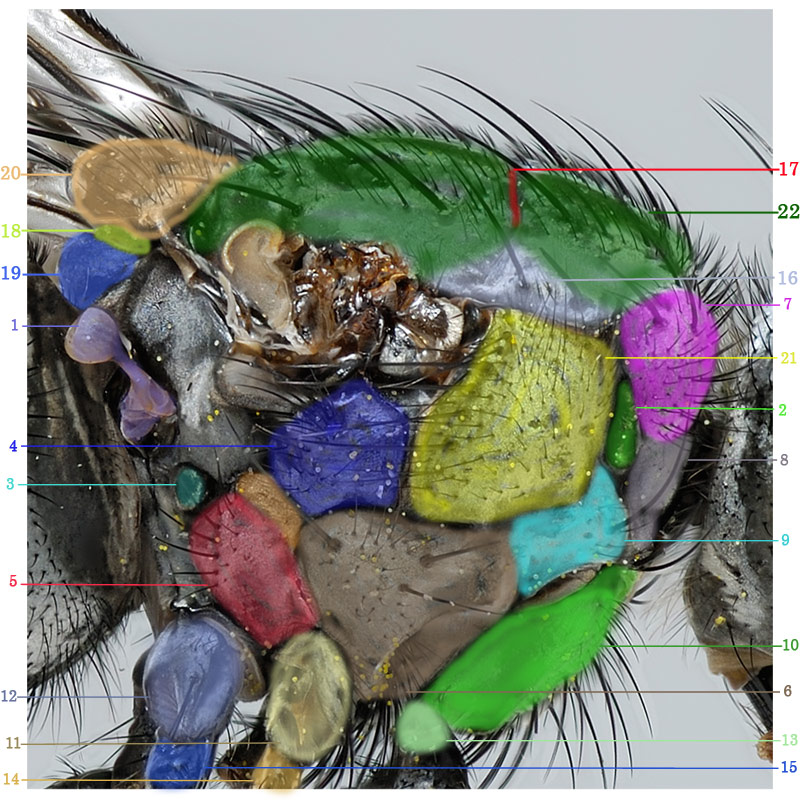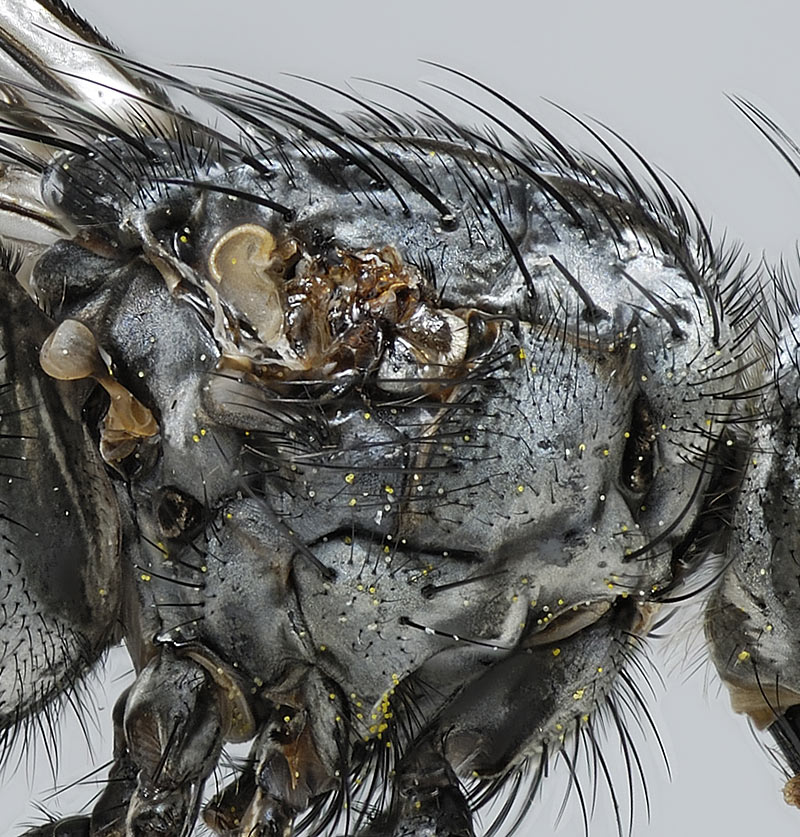Diptera.info :: General Diptera forums :: Overviews
|
Thorax lateral view
|
|
| jorgemotalmeida |
Posted on 27-09-2007 18:43
|
|
Member Location: Viseu - PORTUGAL Posts: 9296 Joined: 05.06.06 |
Thorax of Tachinidae - Dexiinae. Photo copyright ? A.W. Thomas. 1 - haltere 2 - anterior spiracle 3 - posterior spiracle 4 - anepimeron 5 - meron 6 - katepisternum 7 - postpronotum 8 - proepisternum 9 - proepimeron 10 - coxa 1 11 - coxa 2 12 - coxa 3 13 - trochanter 1 14 - trochanter 2 15 - trochanter 3 16 - notopleuron 17 - transverse suture 18 - subscutellum 19 - postscutellum 20 - scutellum 21 - anepisternum 22 - scutum jorgemotalmeida attached the following image:  [188.72Kb] Edited by jorgemotalmeida on 27-09-2007 21:30 |
| jorgemotalmeida |
Posted on 27-09-2007 18:49
|
|
Member Location: Viseu - PORTUGAL Posts: 9296 Joined: 05.06.06 |
Original photo. Photo copyright ? A.W. Thomas. jorgemotalmeida attached the following image:  [194.85Kb] Edited by jorgemotalmeida on 27-09-2007 21:43 |
| jorgemotalmeida |
Posted on 27-09-2007 19:05
|
|
Member Location: Viseu - PORTUGAL Posts: 9296 Joined: 05.06.06 |
Notes: 1) Below the number 13 begins the femur 1. Edited by jorgemotalmeida on 27-09-2007 19:05 |
| Tony Irwin |
Posted on 27-09-2007 19:42
|
|
Member Location: Norwich, England Posts: 7327 Joined: 19.11.04 |
Hi Jorge - this is a great start -  I have a couple of corrections, though -  You have the anepisternum coloured yellow and numbered "3" (confusion with posterior spiracle) The notopleuron (your number 16) usually refers to just the triangular area with two large bristles at the "base" of the suture - i.e. just the bit above the anepisternum. The area infront and behind it are just lateral areas of the scutum. Tony ---------- Tony Irwin |
|
|
|
| conopid |
Posted on 27-09-2007 20:03
|
|
Member Location: United Kingdom Posts: 1039 Joined: 02.07.04 |
Jorge, The colours are very useful. It's good to also see the original photo, without the added colours. As Tony I says - this is a great start. This will be a very useful resource. 
Nigel Jones, Shrewsbury, United Kingdom |
|
|
|
| jorgemotalmeida |
Posted on 27-09-2007 20:23
|
|
Member Location: Viseu - PORTUGAL Posts: 9296 Joined: 05.06.06 |
Thank you a lot, Tony. I will fix it right now. The numbers were repeated.  Thank you, Nigel. 
Edited by jorgemotalmeida on 27-09-2007 20:51 |
| jorgemotalmeida |
Posted on 27-09-2007 21:32
|
|
Member Location: Viseu - PORTUGAL Posts: 9296 Joined: 05.06.06 |
Tony T, I fixed it.  I would like to acknowledge your photos and I'm grateful the fact that you shared to me the photos. Edited by jorgemotalmeida on 27-09-2007 21:59 |
| zcuc |
Posted on 16-12-2007 00:34
|
|
Member Location: Israel Posts: 492 Joined: 08.10.07 |
Am I right that 7.postpronotum = humeri |
|
|
|
| jorgemotalmeida |
Posted on 24-12-2007 18:24
|
|
Member Location: Viseu - PORTUGAL Posts: 9296 Joined: 05.06.06 |
In Asilidae: postpronotal lobe, pprn lb; humerus (pl. humeri); humeral callus [1]; postpronotum [7]; humeral callus = posterior area of posterior pronotum [8] your humeri is the postpronotal lobe in Asilidae for example. Usually the humeral callus (=humerus - in singular) in Tachinidae (and others) refers to the postpronotum. Remember that humeri is the plural of humerus.  |
| Jump to Forum: |













